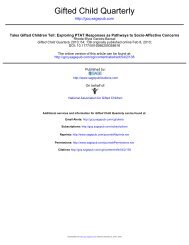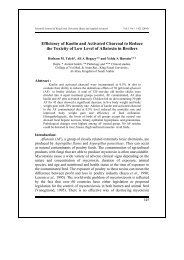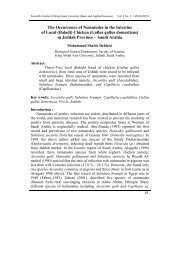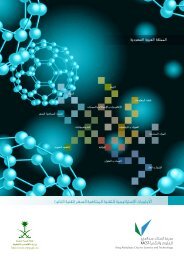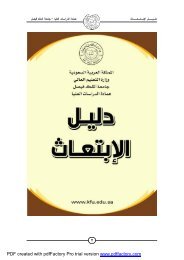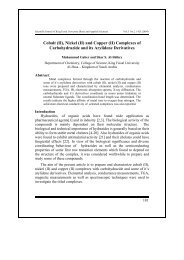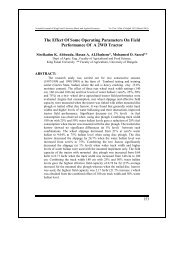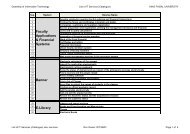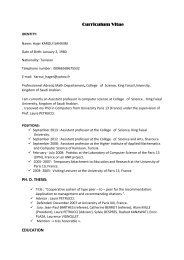Determination of Heavy Metal levels in Common Spices Al-Eed ...
Determination of Heavy Metal levels in Common Spices Al-Eed ...
Determination of Heavy Metal levels in Common Spices Al-Eed ...
Create successful ePaper yourself
Turn your PDF publications into a flip-book with our unique Google optimized e-Paper software.
<strong>Determ<strong>in</strong>ation</strong> <strong>of</strong> <strong>Heavy</strong> <strong>Metal</strong> <strong>levels</strong> <strong>in</strong> <strong>Common</strong> <strong>Spices</strong><br />
<strong>Al</strong>-<strong>Eed</strong>, M. A., F. N Assubaie, M. M. El-Garawany*, H. EL-Hamshary<br />
and Z. M. ElTayeb<br />
Dept. <strong>of</strong> Chemistry & Botany , College <strong>of</strong> Agricultural & Food Sciences<br />
K<strong>in</strong>g Faisal University, P.O. Box 420, <strong>Al</strong>-Hasa 31982, Saudi Arabia<br />
ABSTRACT<br />
The concentrations <strong>of</strong> some heavy metals such as lead (Pb), cadmium<br />
(Cd) , cobalt (Co), and selenium (Se) present <strong>in</strong> common spices available at<br />
local markets <strong>in</strong> Saudi Arabia were determ<strong>in</strong>ed us<strong>in</strong>g atomic absorption. The<br />
study showed differences <strong>in</strong> metal concentrations accord<strong>in</strong>g to the edible part<br />
(root, stem, leaf, and fruit). The concentration <strong>of</strong> lead (Pb) ranged from trace<br />
to 14.30 mg kg -1 on dry weight basis, where as that <strong>of</strong> cadmium (Cd) was<br />
ranged from 1.25 mg Kg -1 to 3.05 mg Kg -1 . The concentration level <strong>of</strong> cobalt<br />
was from zero to 0.64 mg kg -1 . While variable <strong>levels</strong> <strong>of</strong> selenium were<br />
detected from zero to 13.3 mg kg -1 . Some <strong>of</strong> these concentrations are above<br />
the standard limit approved by WHO and FAO. No risk from daily <strong>in</strong>take <strong>of</strong><br />
the most <strong>of</strong> spices under study for hazardous Pb, Cd, Co, and Se if the human<br />
take about 20 g <strong>of</strong> spices per day. But there are dangrous from basisic, thym<br />
and g<strong>in</strong>ger for lead. While the dangrous <strong>of</strong> cadmium is from fenugreek.<br />
_______________________________________________________________<br />
*Permanent address: Soil Fertility and Plant Nutrition Res. Dept., Soil, Water<br />
and Environ. Res. Inst., Agric Res. Center. Egypt.<br />
١
INTRODUCTION<br />
The widespread <strong>of</strong> contam<strong>in</strong>ation with heavy metals <strong>in</strong> the last decades has<br />
raised public and scientific <strong>in</strong>terest due to their dangerous effects on human<br />
health (Gilbert 1984). This has led researchers allover the world to study the<br />
pollution with heavy metals <strong>in</strong> air, water, and foods to avoid their harmful<br />
effects (Zakrzewski, 1991; Kennish, 1992; Oehme, 1989), and to determ<strong>in</strong>e<br />
their permissibility for human consumption.<br />
<strong>Spices</strong> are dried parts <strong>of</strong> plants, which have been used as diet components<br />
<strong>of</strong>ten to improve color, aroma, palatability and acceptability <strong>of</strong> food. They<br />
consist <strong>of</strong> rihzomes, barks, leaves, fruits, seeds, and other parts <strong>of</strong> the plant (<br />
Wahid et.al. 1989). Most <strong>of</strong> these are fragrant, aromatic and pungent. The<br />
bulk <strong>of</strong> the dry material <strong>of</strong> spices conta<strong>in</strong>s carbohydrates, and organic<br />
compounds hav<strong>in</strong>g diverse functional groups. The addition <strong>of</strong> spices -that<br />
may be contam<strong>in</strong>ated with trace and heavy metals- to food as a habit may<br />
result <strong>in</strong> accumulation <strong>of</strong> these metals <strong>in</strong> human organs and lead to different<br />
health troubles.<br />
<strong>Heavy</strong> metals are those with atomic weights from 63.546 to 200.590<br />
(K<strong>in</strong>nish 1992), and specific weight higher than 4 (Connell et. al. 1992).<br />
These metals may reach and contam<strong>in</strong>ate plants, vegetables, fruits and canned<br />
foods through air, water, and soil dur<strong>in</strong>g cultivation (Husa<strong>in</strong> et al, 1995;<br />
Ozores et al, 1997; Geert et al., 1989), and also dur<strong>in</strong>g <strong>in</strong>dustrial process<strong>in</strong>g<br />
and packag<strong>in</strong>g (lbert, 1984; Tsoumbaris et al., 1994).<br />
٢
Thus several studies were done to determ<strong>in</strong>e the concentration <strong>of</strong> heavy<br />
metals <strong>in</strong> spices, dry fruits, and plant nuts ( Wahid et. al. 1989, Gilbert 1984,<br />
Husa<strong>in</strong> et al, 1995), and to study their dangerous effects. Subject<strong>in</strong>g to trace<br />
and heavy metals above the permissible affect the humman health and may<br />
result <strong>in</strong> illness to human fetus, abortion and preterm labor, and mental<br />
retardation to children. Adults also may experience high blood pressure,<br />
fatigue and kidney and bra<strong>in</strong> troubles (FAO 1984).<br />
The K<strong>in</strong>gdome <strong>of</strong> Saudi Arabia (KSA) imports spices among a lot <strong>of</strong> food<br />
stuff from everal countries. These spices may be subjected to contam<strong>in</strong>ation<br />
by way or more as described above. We are not aware <strong>of</strong> published data or<br />
results about the contam<strong>in</strong>ation and concentration <strong>of</strong> trace and heavy metals <strong>in</strong><br />
spices available <strong>in</strong> the local markets <strong>of</strong> K. S. A. except that <strong>of</strong> Selim et. al.,<br />
1994, and <strong>Al</strong>-<strong>Eed</strong> et. al., 1997, which were done for a very few k<strong>in</strong>ds <strong>of</strong><br />
spices.<br />
The objective <strong>of</strong> this work is to estimate the <strong>levels</strong> <strong>of</strong> some heavy metals<br />
i.e. lead, cadmium, cobalt, and selenium that may be present <strong>in</strong> spices<br />
available <strong>in</strong> local markets <strong>in</strong> <strong>Al</strong>-Hasa region. <strong>Al</strong>so, the <strong>levels</strong> <strong>of</strong> <strong>in</strong>vestigated<br />
metals were recommended by the International Organizations (FAO and<br />
WHO).<br />
Material and Methods<br />
<strong>Spices</strong> Samples were collected from local markets, Recognized and<br />
classified accord<strong>in</strong>g to their English name, scientific name, and the used part<br />
<strong>of</strong> the plant (Table 1). Sample orig<strong>in</strong> is not specified.<br />
٣
Sample preparation<br />
Samples were cleaned and oven-dried at 80 C o for ≈ 12 hrs before<br />
chemical analysis. The dried samples were ground <strong>in</strong> a sta<strong>in</strong>less steel mill till<br />
obta<strong>in</strong><strong>in</strong>g f<strong>in</strong>e particles that pass through a 0.5 mm mesh and kept dry for<br />
analysis.<br />
Table I . Scientific and common names <strong>of</strong> studied spices<br />
<strong>Common</strong> name Scientific name Family Used part<br />
Cum<strong>in</strong> Cum<strong>in</strong>um cym<strong>in</strong>um Umbellifeae or Apiaceae Seeds<br />
Coriander Coriandium sativum Umbellifeae or Apiaceae Seeds<br />
Nigella Nigell sativa Umbellifeae or Apiaceae Seeds<br />
C<strong>in</strong>namon C<strong>in</strong>namonum zylanicum Lauraceae Bark<br />
Fenugreek Trigonella foenumgraecum Legomnoseae Seeds<br />
Basibic Ocumimum, ssp Labiatae Leaves<br />
Nasturitium Lipidium sativum Cruciferae Seeds<br />
Mahalib Prunus mahalib Labiatae<br />
Turmeric Cuccuma longa Z<strong>in</strong>giberaceae Rhizomes<br />
Thyme Thymus vulgaris Labiatae Leaves<br />
Black pepper Capsicum nigrum Piperaceae Seeds<br />
G<strong>in</strong>ger Z<strong>in</strong>giber afficenalis Z<strong>in</strong>giberaceae Rhizomes<br />
Safflower Cathamus t<strong>in</strong>ctorius Asteraceeae Petals<br />
Cardamon Elettaria cardamonum Z<strong>in</strong>giberaceae Seeds<br />
٤
Garden sage Salvia <strong>of</strong>fic<strong>in</strong>alis Labiatae<br />
Nutmeg Myristica fragrance Myristicaceae<br />
Anise Pimp<strong>in</strong>illa anisum Umbellifeae or Apiaceae<br />
Mahaleb cherry Prunus mahaleb Rosaceae<br />
<strong>Determ<strong>in</strong>ation</strong> <strong>of</strong> metal concentration<br />
For determ<strong>in</strong>ation <strong>of</strong> heavy metal concentrations, a wet digestion <strong>of</strong> the<br />
dried samples was done accord<strong>in</strong>g to the method described by Jones and Case<br />
(1990) us<strong>in</strong>g conc. H 2 SO 4 and 30% H 2 O 2 mixture. To a 0.5 g <strong>of</strong> dry-ground<br />
sample placed <strong>in</strong> 100-ml beaker, was added 3.5 mL <strong>of</strong> 30 % H 2 O 2 . The<br />
content <strong>of</strong> the beaker was heated to 100 o C, and the temperature was gradualy<br />
<strong>in</strong>creased to 250 o C, and left at this temperature for 30 m<strong>in</strong>. The beaker was<br />
cooled and more 1 ml <strong>of</strong> 30 % H 2 O 2 was added to the digestion mixture and<br />
the contents were reheated aga<strong>in</strong>. The digestion process was repeated more<br />
than one time until clear solution was obta<strong>in</strong>ed. The clear solution was<br />
transferred <strong>in</strong>to 50-ml volumetric flask, and completed to the mark with<br />
double distilled deionized water. A blank digestion solution was made for<br />
comparison. A standard solution for each element under <strong>in</strong>vestigation was<br />
prepared and used for calibration. <strong>Metal</strong> measurement was performed with a<br />
Perk<strong>in</strong>-Elmer model 2380 Atomic Absorption Spectrometer, double beam and<br />
deuterium background correction. Hollow cathode lamps <strong>of</strong> Pb, Cd, Co and Se<br />
were used at specific wave length <strong>of</strong> every metal. Measurements were done<br />
aga<strong>in</strong>st metal standard solutions.<br />
The daily <strong>in</strong>take (mg kg -1 day -1 ) was calculated based on these suppose<br />
1) The human weight is 50 kg and 2) The human <strong>in</strong>take from spices<br />
per day is 20 g<br />
٥
The daily <strong>in</strong>take (mg kg -1 day -1 ) =<br />
metal concentration <strong>in</strong> spice × 20/1000 /50<br />
RESULTS AND DISCUSSION<br />
The contents <strong>of</strong> Pb, Cd, Co and Se <strong>in</strong> different common spices were<br />
presented <strong>in</strong> Table 2. The values <strong>of</strong> metal concentrations were compared with<br />
the maximum permissible concentration <strong>of</strong> 0.30, 0.2, and 3.50 mg kg -1 for Pb,<br />
Cd, Co and Se respectively as recommended by Codex <strong>Al</strong>imentarius<br />
Commission (FAO/WHO 1984).<br />
The lead contents <strong>of</strong> different samples are given <strong>in</strong> Table 2. As<br />
compare<strong>in</strong>g with standard limit, the basibic sample has the highest content <strong>of</strong><br />
lead (1.4 mg kg -1 ) that far exceeds the standard level recommended by FAO/<br />
WHO(FAO/WHO 1984)(0.30 mg kg -1 ). Samples <strong>of</strong> g<strong>in</strong>ger, cardamon and<br />
thyme also conta<strong>in</strong>ed higher concentrations <strong>of</strong> lead (0.4-0.9 mg kg -1 ) than that<br />
recommended by FAO/ WHO (FAO/WHO 1984). However, zero read<strong>in</strong>gs<br />
were obta<strong>in</strong>ed for turmeric, safflower, nutmeg, fenugreek, garden sage,<br />
mahaleb cherry, c<strong>in</strong>namon, nasturitum, basibic, nigella, black pepper, cum<strong>in</strong><br />
and coriander.<br />
As shown <strong>in</strong> Table 2, the concentrations <strong>of</strong> cadmium <strong>of</strong> all the samples<br />
under <strong>in</strong>vestigation were under the maximum permissible concentration (0.20<br />
mg kg -1 ) <strong>of</strong> cadmium (FAO/WHO 1984). The amount <strong>of</strong> cadmium was <strong>in</strong> the<br />
range 0.04 mg kg -1 <strong>in</strong> fenugreek and coriander to 0.14 mg kg -1 for cardamon.<br />
This high level <strong>of</strong> cadmium might be due to the use <strong>of</strong> cadmium-conta<strong>in</strong><strong>in</strong>g<br />
phosphate fertilizers, or from the practice <strong>of</strong> grow<strong>in</strong>g these plants on soil<br />
amended with sewage sludge, or both. However, other samples like turmeric,<br />
garden sage, thyme, mahaleb cherry, c<strong>in</strong>namon, and black pepper show no<br />
detectable amount <strong>of</strong> cadmium. These results may agree with what was<br />
٦
eported earlier ( Waldraw and St<strong>of</strong>en 1974) that lead concentration <strong>in</strong> food<br />
products ranged from undetectable <strong>levels</strong> to a few mg kg -1 <strong>of</strong> wet weight.<br />
Table 2 : Elements concentrations (mg kg -1 ) on dry weight basis <strong>of</strong> studed<br />
commen spices<br />
<strong>Spices</strong> name<br />
Element (mg kg -1 on dry weight basis)<br />
Lead Cadmium Cobalt Selenium<br />
Turmeric Nil 0.10 0.32 4.40<br />
Safflower Nil Nile Nil 13.30<br />
Nutmeg Nil 0.03 Nil Nil<br />
Basisic 1.40 0.12 0.32 Nil<br />
Nasturitum 0.20 0.12 0.32 Nil<br />
Fenugreek Nil 40 Nil Nil<br />
Garden sage Nil Nil Nil 4.40<br />
Thym 0.90 Nil 0.64 6.60<br />
Mahlib Nile Nil Nil 6.60<br />
C<strong>in</strong>namon Nil Nil Nil 2.20<br />
G<strong>in</strong>ger 0.60 0.07 0.32 Nil<br />
Cardamom 0.40 0.14 Nil Nil<br />
Nigella Nil Nil Nil 4.40<br />
Black Pipper Nil Nil Nil Nil<br />
Cum<strong>in</strong> Nil 0.08 Nil 4.40<br />
Coriander Nil 0.04 Nil Nil<br />
Standard limit 0.30 0.20 0.4 3.50<br />
٧
Varied <strong>levels</strong> <strong>of</strong> cobalt concentration were found as shown <strong>in</strong> Table 2.<br />
Samples <strong>of</strong> turmeric, megnut, fenugreek, garden sage, mahaleb cherry,<br />
c<strong>in</strong>namon, cardamon, nigella, black pepper, cum<strong>in</strong> and coriander are almost<br />
free from cobalt. While the rest <strong>of</strong> samples conta<strong>in</strong>ed variable amount <strong>of</strong><br />
cobalt 0.32-0.64 mg kg -1 .<br />
The <strong>levels</strong> <strong>of</strong> selenium are given <strong>in</strong> Table 2. The data shows variation <strong>in</strong><br />
concentration <strong>of</strong> selenium for the <strong>in</strong>vestigated spices. Thus zero read<strong>in</strong>gs<br />
were obta<strong>in</strong>ed for nutmeg, basisic, nasturitum, fenugreek, g<strong>in</strong>ger, cardamon,<br />
black pepper, and coriander. The rest <strong>of</strong> samples conta<strong>in</strong>ed amount <strong>in</strong> the<br />
range 2.2 mg kg -1 <strong>in</strong> c<strong>in</strong>namon to 13.3 mg kg -1 <strong>in</strong> safflower. Other spices that<br />
exceed the recommended FAO/ WHO (1984) level <strong>in</strong>cluded turmeric,<br />
safflower, garden sage, thyme, mahaleb cherry, nigella and cum<strong>in</strong> (3.50 mg<br />
kg -1 ).<br />
The rsults <strong>in</strong> Table 3 showed that no risk from daily <strong>in</strong>take <strong>of</strong> the most <strong>of</strong><br />
spices under study for hazardous Pb, Cd, Co, and Se if the human <strong>in</strong>take is<br />
about 20 g <strong>of</strong> spices per day. But there are dangrous from basisic, thym and<br />
g<strong>in</strong>ger for lead. Due to the high level <strong>of</strong> cadmium found <strong>in</strong> fenugreek therefor<br />
it could poisonous.<br />
In conclusion, Accord<strong>in</strong>g to ATSDR (2001), the m<strong>in</strong>imal risk <strong>levels</strong> for<br />
hazardous Pb, Cd, Co and Se through oral route and has acute effect are<br />
0.0002, 0.0002, 0.01, 0.005 mg kg -1 day -1 respectively. whereas the human<br />
needs from spices is very few grams per day there is no risk from used the<br />
species under study <strong>in</strong> the food. And also, there should be thorough control<br />
for imported food stuff at customs to meet FAO/ WHO recommendations and<br />
tolerable daily <strong>in</strong>take limits for heavy metals, and to avoid the pass<strong>in</strong>g for<br />
human consumption and prevent unknown disease.<br />
٨
Table 3 : Daily <strong>in</strong>take (mg kg -1 day -1 ) more than 20 g <strong>of</strong> metals <strong>of</strong> studed<br />
commen spices effect based on 50 g <strong>of</strong> human body.<br />
<strong>Spices</strong> name<br />
Risk duration for metal<br />
Lead Cadmium Cobalt Selenium<br />
Turmeric No effect No effect No effect No effect<br />
Safflower No effect No effect No effect No effect<br />
Nutmeg No effect No effect No effect No effect<br />
Basisic Acute No effect No effect No effect<br />
Nasturitum No effect No effect No effect No effect<br />
Fenugreek No effect acute No effect No effect<br />
Garden sage No effect No effect No effect No effect<br />
Thym Acute No effect No effect No effect<br />
Mahlib No effect No effect No effect No effect<br />
C<strong>in</strong>namon No effect No effect No effect No effect<br />
G<strong>in</strong>ger Acute No effect No effect No effect<br />
Cardamom No effect No effect No effect No effect<br />
Nigella No effect No effect No effect No effect<br />
Black Pipper No effect No effect No effect No effect<br />
Cum<strong>in</strong> No effect No effect No effect acute<br />
Coriander No effect No effect No effect No effect<br />
M<strong>in</strong>imal risk <strong>levels</strong> 0.0002 0.0002 0.01 0.005<br />
٩
Acknowledgement<br />
The authors would like to thank Deanship <strong>of</strong> Scientific Research, K<strong>in</strong>g<br />
Faisal University for grant fund <strong>of</strong> 1026 project.<br />
REFERENCES<br />
<strong>Al</strong>-<strong>Eed</strong>, M. A., M.S. <strong>Al</strong>-Jasser and A. L. Selim. 1997. The chromatographic<br />
determ<strong>in</strong>ation <strong>of</strong> fatty acids content and the chemical characteristics <strong>of</strong><br />
some Saudi spices. J. Agric. Sci. Mansoura. Univ., 22(5): 1685-1692.<br />
ATSDR .2001.Agency for toxic substances and disease registry. From web <strong>of</strong><br />
http://www.atsdr.cdc.gov/mrls.html.<br />
FAO/WHO.1984. Jo<strong>in</strong>t FAO/WHO Food Standers Program, Codex<br />
<strong>Al</strong>imentarius Commission Contam<strong>in</strong>ation. CAC/Vol. XV11.FAO, Roma<br />
and WHO, Geneva.<br />
Geert, E., W. van Loon Johannes, and T. Kars. 1989. <strong>Heavy</strong> metals <strong>in</strong><br />
vegtables grown <strong>in</strong> the Netherlands and <strong>in</strong> domestic and imported fruits. Z<br />
Lebensm Unters Forsch 190:34-39.<br />
Gilbert, J. 1984. Analysis <strong>of</strong> food contam<strong>in</strong>ation. Elsevier App. Sci. Pups.,<br />
London 1.<br />
Husa<strong>in</strong>, A., Z. Baroon, S. <strong>Al</strong>-Khalafawi, T. <strong>Al</strong>-Ati and W. Sawaya. 1995.<br />
<strong>Heavy</strong> metals <strong>in</strong> fruits and vegetables grown <strong>in</strong> Kuwait dur<strong>in</strong>g the oil well<br />
fires. Arab Gulf J. Sci. Research. 13: (3)535-542.<br />
Kennish, M. J. 1992. Ecology <strong>of</strong> Estuaries. Anthropogenic effects. CRC.<br />
Press, Inc., Boca Raton, F1.<br />
Nitrates, Nitrites, and N-nitroso Compounds. Geeneva, World Health<br />
Organization, 1978 (Environmental Health Criteria 5).<br />
Oehme, F. W. 1989. Toxicity <strong>of</strong> heavy metals <strong>in</strong> the environment. Marcel<br />
Dekker, Inc., New York, Part 1, 1.<br />
Ozores-Hampton M., E. Hanlon, H. Bryan and B. Schaffer. 1997. Cadmium,<br />
copper, lead, nickel and z<strong>in</strong>c concentrations <strong>in</strong> tomato and squash grown<br />
<strong>in</strong> MSW compost-amended calcareous soil. Compost Sci and Utilization.<br />
5: (4) 40-45.<br />
Sattar, A, M. Wahid and S.K Durrani. 1989. Concentration <strong>of</strong> selected<br />
heavy metals <strong>in</strong> spices, dry fruits and plant nuts. Plant Foods For<br />
Human Nutrition. 39(3) 279-286.<br />
Selim, A.I., M.S. <strong>Al</strong>-Jasser and M. A. <strong>Al</strong>-<strong>Eed</strong>. 1994. The fatty acids<br />
composition and the chemical characteristics <strong>of</strong> some umbelliferae spices.<br />
Annals <strong>of</strong> Agric. Sc. Moshtohor. 32(4): 1995-2004.<br />
١٠
Tsoumbaris, P. and H. Tsoukali-Papadopoulou. 1994. <strong>Heavy</strong> metals <strong>in</strong><br />
common foodstuff: quantitative analysis. Bullet<strong>in</strong> <strong>of</strong> environmental<br />
contam<strong>in</strong>ation and toxicology. 53: part 1. pp. 61-66.<br />
Waldraw, H. A., St<strong>of</strong>en, D. (1974) Sub-clionical lead poison<strong>in</strong>g. Academic<br />
Press, London<br />
Zakrzewski, S. F. 1991. Pr<strong>in</strong>ciple <strong>of</strong> environmental toxicology. ACS<br />
Pr<strong>of</strong>essional reference book, Wash<strong>in</strong>gton, DC, 1.<br />
الملخص العربي<br />
مستوي بعض من العناصر الثقيلة في البهارات الشائعة<br />
محمد العيد، فهد السبيعي، محمد الجرواني ، هاني الهمشري ، الزين الطيب<br />
قسم الكيمياء والنبات - آلية العلوم الزراعية والأغذية<br />
جامعة الملك فيصل – ص ب ٤٢٠، الأحساء ٣١٩٨٢، المملكة العربية السعودية<br />
قدرت آمية العناصر الثقيلة الرصاص والكادميوم والكوبالت و السلنيوم في بعض من البهارات<br />
الشائعة الأستعمال في الأسواق المحلية بالمملكة العربية السعودية [استخدام جهاز التقدير الذري. وقد<br />
وضحت الدراسة وجود فروق في ترآيزات المعادن المختلفة طبقا للجزء المستعمل في الأآل (جذر،<br />
ساق، الأوراق، ثمار). تراوح ترآيز الرصاص من آميات ضئيلة غير مقدرة علي الجهاز الي ١٤٫٣٠<br />
مليجرام/آجم علي اساس الوزن الجاف بينما آان ترآيز الكادميوم يختلف من ١٫٢٥ مليجرام/آجم الي<br />
٣٫٠٥<br />
مليجرام/آجم وآان ترآيز الكوبالت من صفر الي<br />
السلنيوم من صفر الي<br />
٠٫٦٤<br />
١٣٫٣ مليجرام/آجم.<br />
طبقا لمنظمتي ال WHO و . FAO<br />
مليجرام/آجم بينما تراوح ترآيز<br />
آانت بعض من هذه الترآيزات فوق الحد المسموح به<br />
،ليس هناك خطورة من التناول اليومي لجرعة<br />
٢٠ جرام من<br />
لمعظم البهارات تحت الدراسة لشخص يزن أآثر من خمسين آيلوجرام بالنسبة لعناصر الرصاص ،<br />
الكادميوم، الكوبالت، السلنيوم ولكن خطورة حادة تظهر من تأثير الرصاص عند تناول ٢٠ جرام من<br />
أنواع الحبك أو الزعتر و الزنجبيل بينما خطورة الكادميوم تظهر عند تناول نفس الجرعة في اليوم من<br />
الحلبة.<br />
١١
١٢



